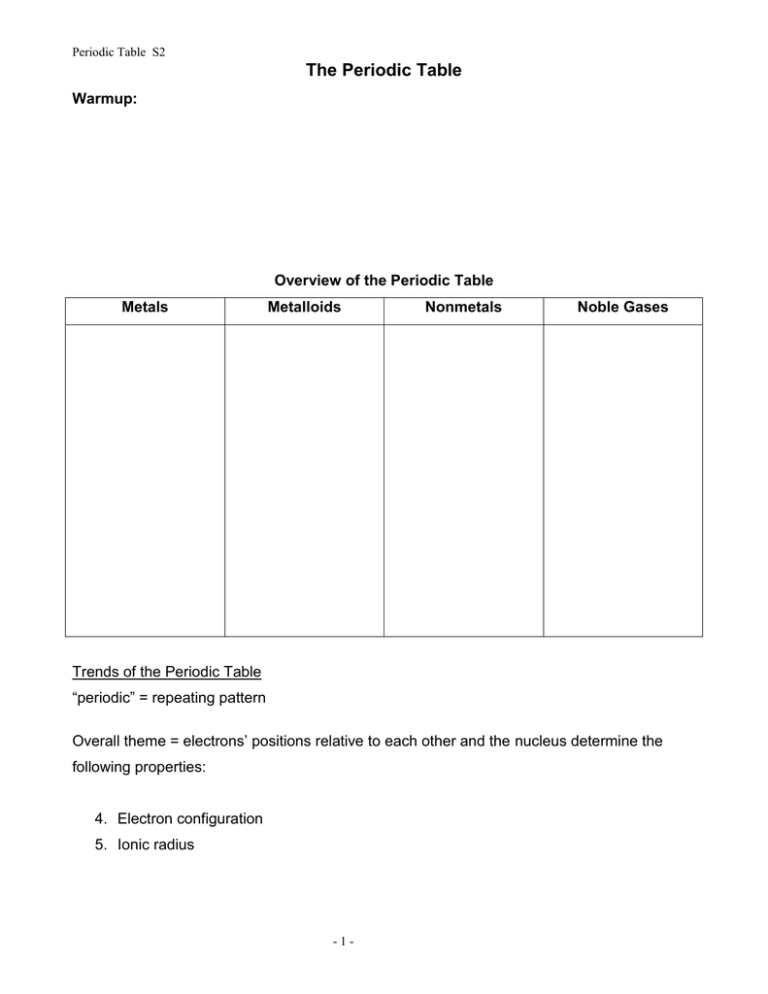The Periodic Table
advertisement

Periodic Table S2 The Periodic Table Warmup: Overview of the Periodic Table Metals Metalloids Nonmetals Noble Gases Trends of the Periodic Table “periodic” = repeating pattern Overall theme = electrons’ positions relative to each other and the nucleus determine the following properties: 4. Electron configuration 5. Ionic radius -1- Periodic Table S2 4. Electron configuration 1A 2A 1 2 H 1s1 He 1s2 Li 2s1 Be 2s2 Na 3s1 Mg 3s2 K 4s1 Ca 4s2 Rb 5s1 B 3-12 3A 4A 5A 6A 7A 8A 13 14 15 16 17 18 F 2s22p5 Ne 2s22p6 B 2s22p1 C 2s22p2 N 2s22p3 O 2s22p4 3s23p1 3s23p2 3s23p3 3s23p4 3s23p5 3s23p6 Sc-Zn 3d 4s24p1 4s24p2 4s24p3 4s24p4 4s24p5 4s24p6 Sr 5s2 Y-Cd 4d 5s25p1 5s25p2 5s25p3 5s25p4 5s25p5 5s25p6 Cs 6s1 Ba 6s2 La-Hg 5d 6s26p1 6s26p2 6s26p3 6s26p4 6s26p5 6s26p6 Fr 7s1 Ra 7s2 Ac-Une 6d (followed 1+ 2+ 2+ by s) 3+ 4+ 1+ or 2+ 3- 2- 1- 4- (generally) B Lanthanide/ Actinide series Begin in period 6 Noble gas configuration = [core] electrons “outer” electrons = “valence” electrons Elements of “A” groups have valence electrons in s and p orbitals. Ce-Lu 4f Th-Lr 5f (followed by s) (Note: USA uses A and B. Rest of world uses 1-18) 1+ or 2+ (generally) The position of a valence electron and the ability to remove it from an atom are related to • the number of protons in the nucleus • the extent to which the valence electron is shielded from the positively-charged nucleus by the negatively-charged core electrons -2- 0 Periodic Table S2 Isoelectronic Series = same number of electrons (iso = equal) 1. Draw the complete electron configuration of each of the following elements. 2. What ions will they form? 3. When ions, how many electrons does each have? How many protons? 4. Predict the relative diameters of the members of this isoelectronic series. Element Electron config Ion O F Ne Na Mg Prediction (smallest to largest): -3- Ion # e- Ion # p+ Periodic Table S2 6. Ionic Radius a) Cations (+) are always SMALLER than the original atom ( # e-’s repulsion and greater pull on the valence e-’s by the nucleus remaining e-’s shrink to nucleus) b) Anions (-) are always LARGER than the original atom ( # e-’s repulsion shell swells) Ionic Radius 1. In this table of ionic radii, how is the charge of the ions of elements in groups 1A-4A related to the group number? _____________________________________________ -4-




